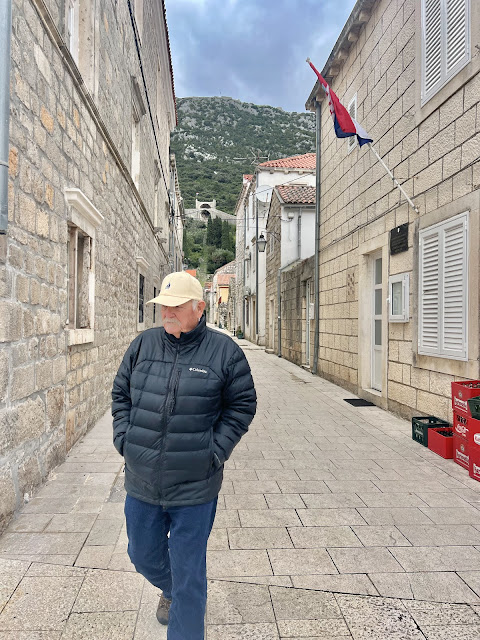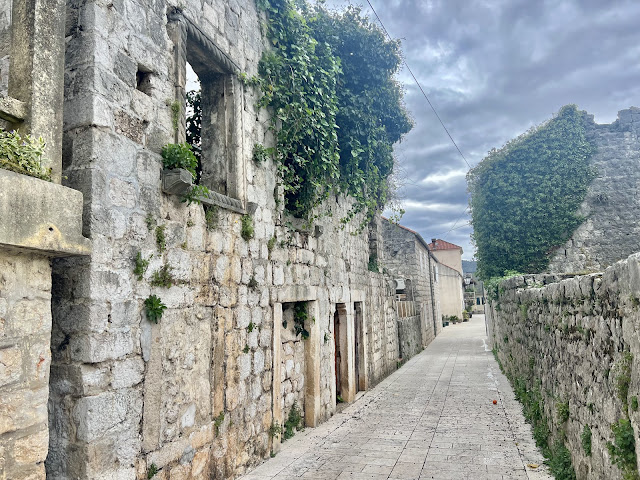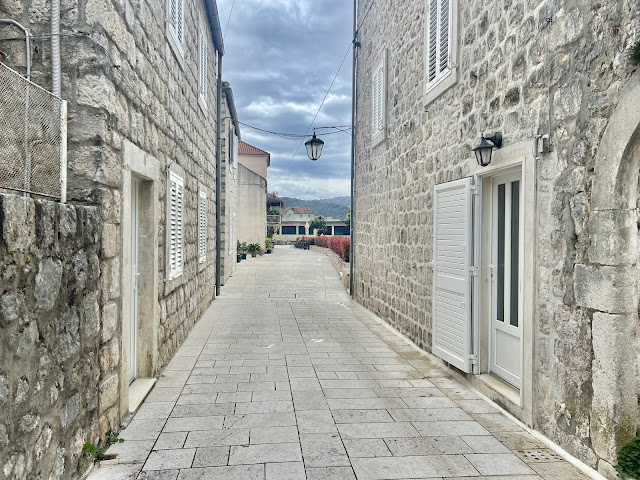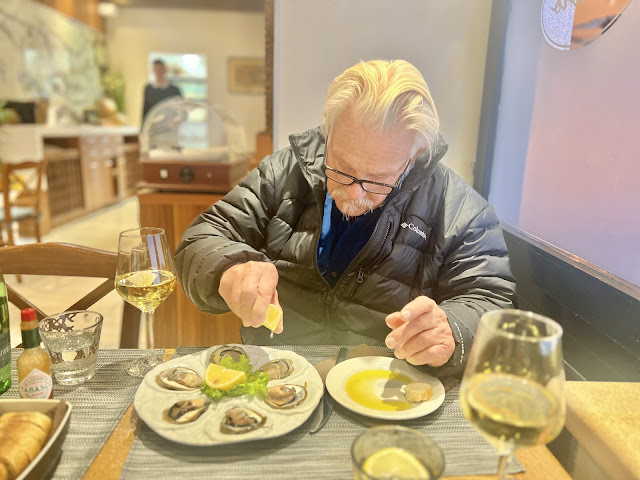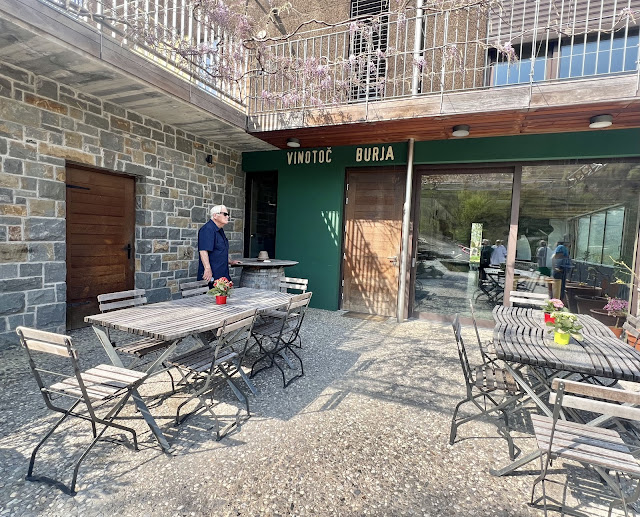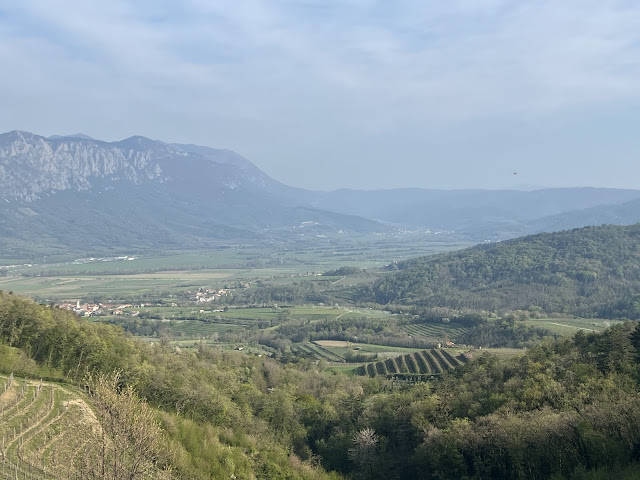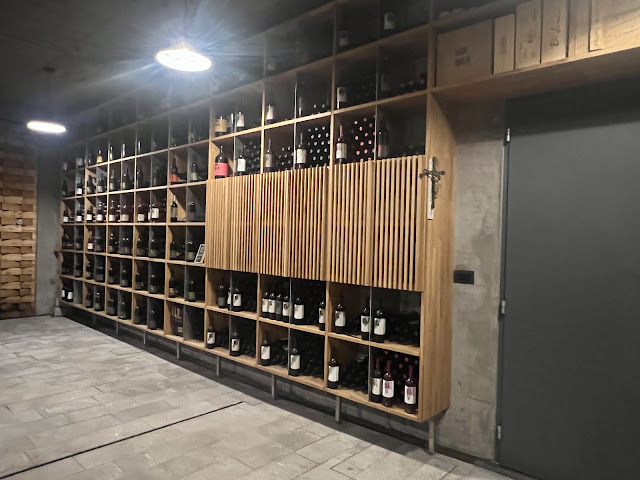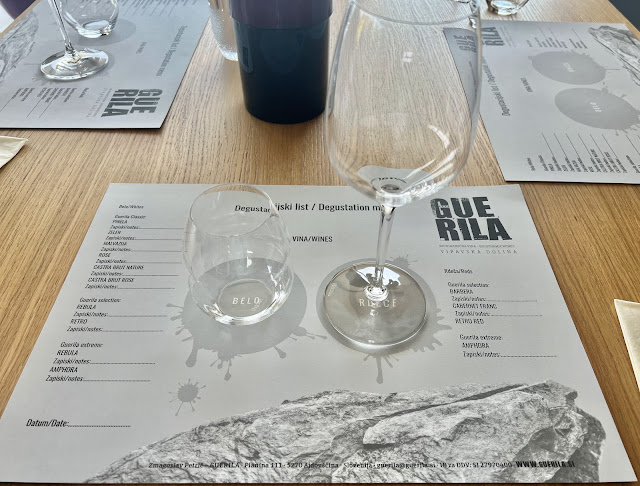When your travels to the Pelješac Peninsula for a wine adventure then you must include a stop in Ston. That early April morning we were picked up in Dubrovnik's historic center and driven to Ston. About an hour later we arrived in Ston, which has a rich history with its stone walls, oyster farms, and salt production. Despite the weather, a cold day with rain showers, we did a brief walk about in Ston, and enjoyed a coffee. We loved walking around the village and discovering some of its past history.
 Exploring Ston © Spaswinefood
Exploring Ston © SpaswinefoodYes, I know most go to Ston for its stone walls, oysters, and salt production.What follows are some of the our discoveries.
Exploring Ston
From the entrance we headed back towards the village. Croatian Flag, Ston © Spaswinefood
We saw the Croatian flag and decided to head down that side street.
Exploring the Streets of Ston © Spaswinefood
It was fun to walk the side streets.
Walking in Ston © Spaswinefood
Another Ston Street (alley way) © Spaswinefood
Exploring theVillage, Ston © Spaswinefood
We loved peeping down the streets/ alley ways of Ston.
Arriving at the Square Ston © Spaswinefood
Eventually we arrived at a large square near the Franciscan monastery of St. Nicolas, one of the largest churches in southern Croatia. The construction of the church started in 1323. There is so much history here for those interested in exploring.
Checking the Square, Ston © Spaswinefood
Franciscan Monastery of St. Nicolas, Ston © Spaswinefood
Indeed Ston is a fishing village with a fascinating history. The Franciscan Monastery of St. Nicolas is an important of that history.
Given it was a cold morning it was time for us to head back for a cup of coffee.
Taking the Views around the Square, Ston © Spaswinefood
Given it was a cold, damp April day we just admired the historical wall from a distance.
Viewing the Historic Walls, Ston © Spaswinefood
Yes, I know most come for the historic wall but we liked exploring the village. There is so much history to discover about the wall.
We headed back, passing wine bars, cafes, and restaurants.
Cardo, Ston © Spaswinefood
During our walk we spotted some friendly cats. One of those was a black and white cat.
Off to the Square: Black & White Cat © Spaswinefood
Gereetings: Black & White Cat © Spaswinefood
On our walk back again we met the black and white cat. Obviously, we were no the only ones out for a walk.
Detective Work: Black & White © Spaswinefood
Further along we met up with two tabby cats.
Tabby Cats, Ston © Spaswinefood
Then towards the end of our walk hanging out in a chair at a cafe was a calico cat.
Taking a Rest © Spaswinefood
Morning at the Cafe © Spaswinefood
I loved getting to meet the cats of Ston on our morning walk.
There are number of churches in Ston. We managed to also see the Crkva Sv. Vlaho Church.
Crkva Sv. Vlaho Church © Spaswinefood
Crkva Sv. Vlaho Church © Spaswinefood
Yes, it was cold.Crkva Sv. Vlaho Church © Spaswinefood
We stopped by a cafe for coffee before leaving.Off to Coffee at Baca, Ston © Spaswinefood
Besides it fascinating history these days Ston is know as an idyllic Adriatic oyster village. Many come to Ston to enjoy oysters.
Oyster Farming, Ston © Spaswinefood
Oyster Farming, Ston © Spaswinefood
It was an early cold morning; and so John did not feel like having oysters. Later back in Dubrovnik he enjoyed some Ston oysters. By that time we have explored a number Pošip wines. John chose to pair Pošip with Ston oysters.
Oyster Time © Spaswinefood
Oysters & Pošip © Spaswinefood

Ston Oysters © Spaswinefood
Enjoying Ston Oysters & Pošip © Spaswinefood
Before leaving Ston we drove by the salt production area. Southeast of Ston are the salt pans, which are among the oldest in the Mediterranean, used for around 4000 years. The basic of production of salt has changed very little since the Middle Ages. Basically the pans fill with seawater, which evaporates in the summer heat, leaving a residue of salt.
From Ston we continued on our Pelješac Peninsula wine adventure. It was just short drive from Ston to Ponikva, the home of the Miloš family winery. Miloš Stagnum is one of the oldest family owned wineries on the Pelješac Peninsula, a sub-region of the South Dalmatia wine region. Miloš Winery, April 6, 2025 © Spaswinefood
Don't forget to stop in Ston. YES, I know most go to Ston to learn about its stone walls, oysters, and salt production however, for us it was mostly cats, churches and coffee. YES, it was a great kickoff for those vine-filled days with wine producers who treated us so well during our Pelješac Peninsula wine travels. After completing the winery visits, we can easily say Pelješac Peninsula wine country is one of Croatia's best kept secrets. We were impressed by the charm of its towns, wineries, and of course its wines. We so look forward to sharing more on future vine-filled explorations in Croatia. I invite you to join us in our wine travels in Italy at Wine Travels with Dr. Sharon, and at Spaswinefood on Bluesky and Facebook.
Cheers
Sharon
April 2025
Pelješac Peninsula, Croatia
© Spaswinefood
Ston, Pelješac, Croatia © Spaswinefood
I would highly recommend
Kresimir Pehar, Dubrovnik 4 U Transfers for those who prefer a driver for your wine country travels.



